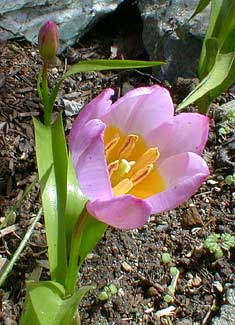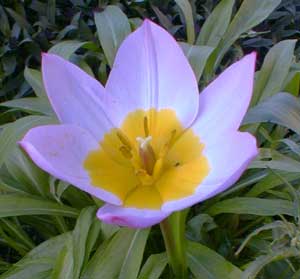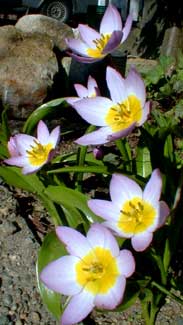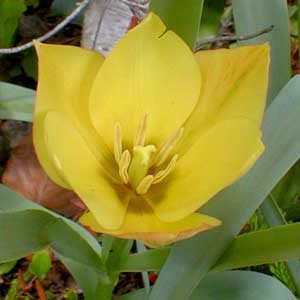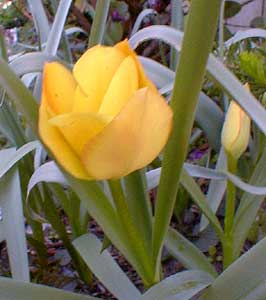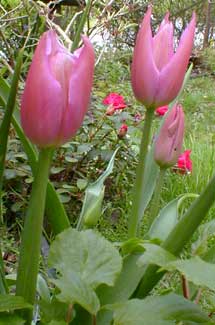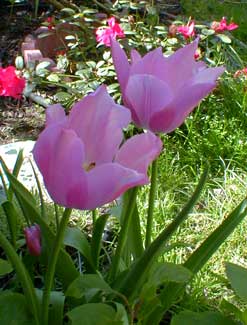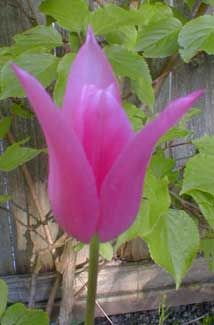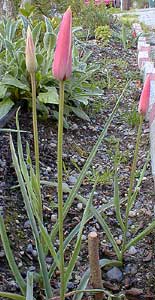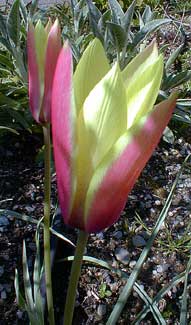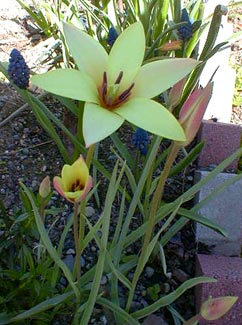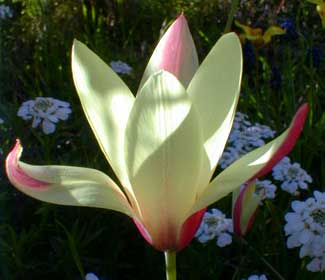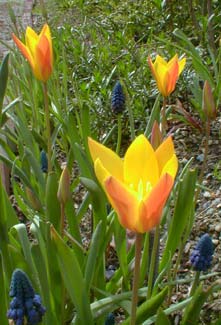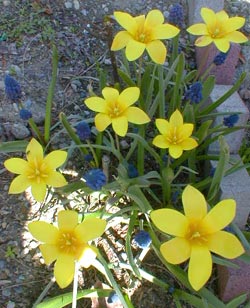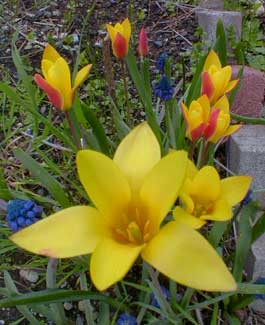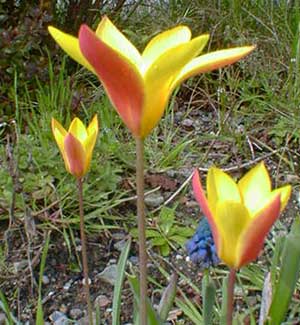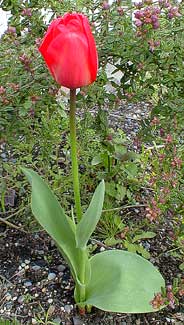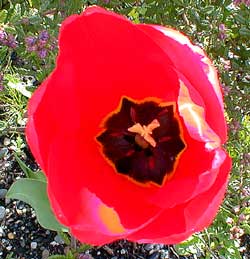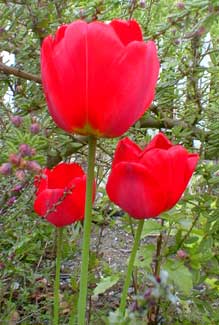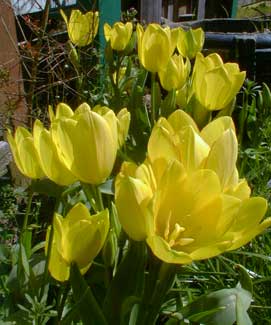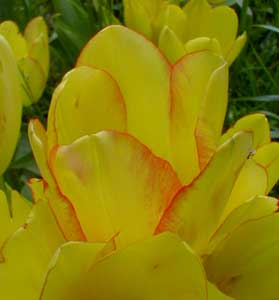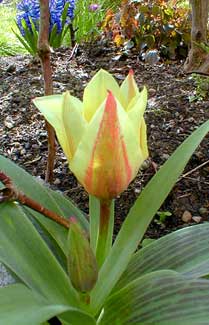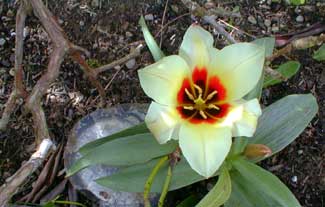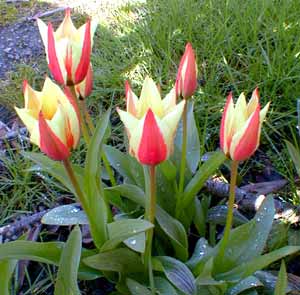-
a n i r t a k

 Tulips
Tulips
Last edited by NEP; 09-17-2010 at 12:17 AM.
-
a n i r t a k

 Re: Tulips
Re: Tulips
'Atilla'
Triumph Tulip
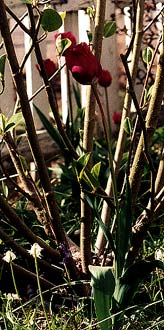
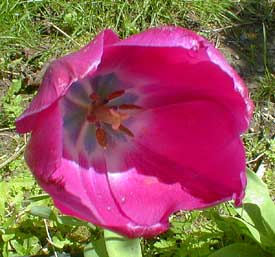
"Dutch tulips from their beds
Flaunted their stately heads."
-The Adventure of a Star
by James Montgomery
(1771-1854)
We have planted mainly species tulips rather than hybrids, but the year we first bought the house, Granny Artemis did put in some Triumph Tulips, plus there were a few Triumphs still popping up from former owners' plantings.
Years later, a few of these "ordinary" hybrids still pop up here & there in the garden. They're not thriving, as hybrids tend to age & weaken & do not perennialize as nicely as do species tulips. Plus the surrounding flourishing gardens, by increasing the shade ratio every year, makes life harder for sun-loving tulips. I've thought from time to time that if I dug these random bulbs up & put them out on the sunny roadside they'd be revitalized, but I'd rather give over the ideal locations to the species tulips, & so let the old hybrids struggle along mostly ignored.
The first photo, snapped in April 2002, shows one of these random tulips with pastel purple bloom, & some tiny white squill nearby. Though I don't know what specific Triumph this would be, my best guess is 'Atilla.' Of the lingering hybrids, 'Atilla' blooms simultaneously with a Apeldoorn Darwin hybrid, followed soonafter by the purple-black 'Queen of Night,' followed by a yellow Triumph. There will be some of them here & there from mid-April until well into May.
This one's growing up amidst the limbs of the Oyama Magnolia that has not yet sprouted many leaves at mid-April, so the tulip almost gets the sun it wants. As other colored Triumphs vanished over time, these purple ones continue. A group of Triumphs elsewhere in the yard in fuller sun used to be mixed colors but now only the pastel purples are there.
The second photo taken April 2003 is from the other patch, snapped in order to show the grey-blue inside-bottom of the cup.
Even though I can see why hybrid tulips are so popular, they'll never out-rate the botanical tulips in my esteem. "Never say never," but we're not likely to intentionally plant a lot of hybrid tulips, though every autumn we add more & more species tulips, such as T. bakeri, T. batalini, T. clusiana, T. hageri, T. kaufmaniana, T. kolpakowskiana, T. marjolettii, T. urumiensis & many others, which we find better suited to naturalistic settings.
-
a n i r t a k

 Re: Tulips
Re: Tulips
'Couleur Cardinal' Tulip,
& the Tulip Fairies
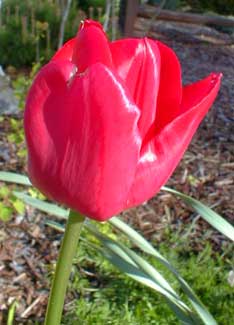
"Our stalks are very straight & tall,
Our colours clear & bright;
Too many-hued to name them all --
Red, yellow, pink, or white.
And some are splashed, & some, maybe,
As dark as any plum.
From tulip-fields across the sea
To England did we come.
We were a peaceful country's pride,
And Holland is its name.
Now in your gardens we abide --
And aren't you glad we came?"
-Cicely Mary Barker's Tulip-fairy Song
Single Early tulips have mid-height sturdy stems usually only about one-foot tall & not at all tippy. The egg-shaped flowers can be had in numerous intense colors, including bright red varieties among which 'Couleur Cardinal' is one of the standards suitable for zones 3 through 8.
They look good in drifts of many of a single color, or popping up singly here & there amidst sundry sun-garden perennials. They bloom early enough that many taller perennials will not yet have reached their late-spring height, so that early single tulips can be scattered amidst echinaceas, sages, & other summer perennials, so that flowers will be numerous above the foliage of surrounding plants that will be tall & flowering after the tulips are finished for the year.
Single-early tulips bloom after kaufmanniana waterlily tulips & fosteriana tulips (such as Emperors), or at the same time as many greigii tulips, but before most hybrid tulips. A few of them are mildly scented, including the intense red 'Couleur Cardinal' although the standard red 'Brilliant Star' is scentless.
Single early tulips hold up to wind & rain extremely well & can be very long-lasting from late March to all of April. They are among the easiest tulips to grow in containers, being very forgiving of their conditions. The bulbs can perennialize for many years without needing to be lifted.
Although tulips come in all colors, it is red that first comes to mind as the most fundamental tulip color. One sees it in poetry which speaks of red tulips, in fairy illustrations wherein tulip-fairies are generally red, & in all sorts of folk art.
This is perhaps because yellow is identified with daffodils & white with Madonna lilies & blue with English bluebells, so that red falls to the tulip as quintessential; whatever the reason, red is the literary ideal whether in writings of Arabia & Persia, or in Europe & North America.
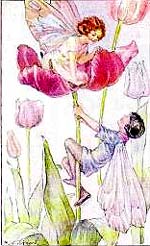
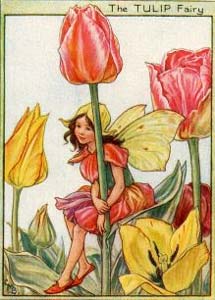
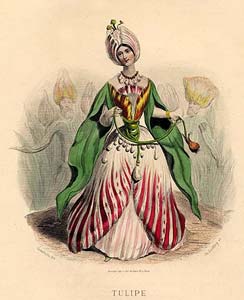
In Islamic symbolism the ideal tulip is lily-flowering with recurved petals, & preferrably red, because this is indicative of the soul's fiery desire for God, or it is because the first tulips were said to have arisen from the blood of the martyred Hussein, son of the Prophet. In the west the "basic" tulip is egg-shaped rather than with recurved petals, but the idealized color is still red.
At first blush (to attempt a pun) the western symbolism of the red tulip is not nearly as infused with Divine meaning as it is for Islam. But it could well be that the egg-shape preferred in the west did does evoke subliminal cultural memories of the age of the Earthmother, among whose symbols was the fertile egg.
Or, if that is too farfetched, the Victorian language of flowers, which borrowed from Near & Far East mythology, made red tulips the symbol of perfect & irresistible Love, but not necessarily of an erotic kind, that being symbolized by a red rose.
This fundamentally pure love is not all that different from the Persian sense that the tulip evoked the soul's eager burning for God. By contrast, yellow tulips in the Language of Flowers indicated hopeless, spurned, or unachievable Love.
But it is in the Tulip Fairy that the supernatural nature of this flower found its last lingering mythological expression for the west. The idea of a Tulip Fairy has found its way into art, poetry, & commerce. If someone lost their mind & wanted to fill their home with Tulip Fairy kitsch, they would be able to find a half-dozen cross-stitch patterns & kits based on art nouveau & Victorian designs, & cross stitch themselves big wall-hangings of tulip-fairies or pillows.
And they could obtain old christmas ornaments in the shape of cherubic-faced fairies issuing from out of tulips -- not to mention a whole array of ornaments based on Cicely Mary Barker flower-fairies & imitations thereof.
Then there's a wide array of tulip-fairy three-dimensional wall plaques, cut crystal, or little figurines of glass, pottery, or pewter. There's a pewter ring studded with semi-precious stones, the main feature being a tulip fairy. There's an end-table lamp or bedlamp with glass base showing a tulip fairy, & more tulip fairies on the lampshade.
There are lovely tulip-fairy stencils so that anything one owns that doesn't come ready-made with tulip fairies all over it can have them added for the sake of a wondrously loony household theme. And one simply must possess in decorative frame the Flower Fairy commemorative coin from the Isle of Mann.
There are tulip fairy greeting cards & stationary sets & bookmarks & posters & candles, & plastic-headed tulip-fairy dolls so grotesquely cute they're horrifying.
There's a tulip fairy jigsaw puzzle, & a tulip-fairy toiletry set with tulip-fairy hairbrush & perfume or body-wash allegedly smelling of tulips so that you, too, can smell like a tulip fairy, without reference to the fact that tulips generally have very little or no scent.
Tulip fairies are encountered in flower-fairy coloring books & other miscellaneous children's books, in blankbooks & diaries, sticker sets, & actual instructions are available on How To Be A Tulip Fairy.
How would one ever get along without that tulip-fairy velvet bag within which one is supposed to keep a Tarot deck. That there are tulip fairy t-shirts is no surprise, but tulip-fairy underwear was a bit more startling.
The tulip-fairy-obsessed lunatic, doubtless masking their own deep depression or hiding their fantasies of infanticide, could even get a toddler halloween costume with a tulip-dress, an inverted tulip for a hat, & red wings, & lug one's kitschy Tulip Fairy Child from house to house on All Hallow's Eve as a temptation to pederasts.
And when the toddler is a bit older, there's a tulip-fairy tutu so that one's wee daughter or sissy son can leap around the house as prima ballerinas. And don't be too surprised that there are also tulip fairy costumes for full grown women and/or drag-queens, so no need ever to outgrow the fashion-disability imposed from infancy onward by one's demented mother.
Yet for all the making-fun one can do, the tulip fairy is the last bastion of pantheistic belief in Nature's sentience. On this page is reproduced an old illustration of a boy & girl tulip fairy climbing amidst the flowers, drawn by Margaret W. Tarrant (1888-1959), whose fairy artwork was once popular in children's books & on post cards; followed by the well known tulip fairy by Cicely Mary Barker (1895-1973) depicted peeping from behind a stem; & a tulip fairy by J. J. Grandville (1485-1527) from a very old French collection of stories of personified flowers. How adorable can it be!
-
a n i r t a k

 Re: Tulips
Re: Tulips
'Lilac Wonder'
Baker's Tulip
"A tulip!" cried the furious old man.
"A tulip! That symbol of pride & lust!"
-The Tulip Vendor,
by Aloysius Bertrand
(1807-1841)
I just so much prefer little species tulips over gaudy big hybrid cultivars. Tulipa bakeri 'Lilac Wonder' begins to poke its leaf-nose out of the ground in late December or in January, & can bloom as early as the end of March, though never later than the first week of April, lasting the whole month of April.
Baker's Tulip is a common wildflower on the island of Crete. It was named after G. P. Baker of the Royal Horticultural Society, who introduced it through the Society in 1895.
Some authorities believe T. bakeri is only a variant of T. saxatilis undeserving of its own species name, though they have sufficiently distinct chromosome signatures that they have not to date been combined taxonomically.
The selected variety 'Lilac Wonder' is the most common Baker's Tulip offered to western gardening. The wild form is a more subdued yellow & mauve, & smaller than the more colorful 'Lilac Wonder,' hence not as popular, though sometimes available from spets.
Due again to the close similarity of T. bakeri & T. saxatalis, 'Lilac Wonder' was initially categorized as a color variant of T. saxatilis, being a bit larger than wild specimens of T. bakeri. But the registraiton committee found that it had the chromosomes of T. bakeri.
This specific selected variety was introduced to gardening in 1971 by Kees Visser, who obtained the initial bulbs from Gerald H. Hageman of the International Flower Bulb Center (Internationaal Bloembollen Centrum) in Hillegom, The Netherlands.
It grows to only about eight inches tall at most, with beautiful big cup-flowers that are pastel lilac on the outside & on the inner tips, & brilliant yellow at the heart. The leaves coil backward slightly, remaining close to the ground.
It loves full sun with moist soil while it is growing in spring, dry in winter. They naturalize very easily. Our first little patch began with ten bulbs. The ones shown in the first & second photos on this page are blooming at foot of a Wentworth Cranberry by the back porch.
These were the first ones we planted (in Autumn 2002). Under the cranberry viburnum they get only afternoon sun, probably a little less of that than would be ideal, yet they have bloomed wonderfully in Aprils 2003 & 2004.
As the cranberry gets bushier the tulips are bound to end up with even less sun, by which time it may be necessary to lift & divide the bulbs anyway, & then I'll decide whether or not I need to find a sunnier spot for them.
In the meantime, we've already planted nine more 'Lilac Wonder' bulbs in a sunny streetside garden at the foot of the 'Aphrodite' Rose of Sharon, mixing them in with little 'Sundisc' Jonquils. The second photo is one of the tulips abloom in this sunnier location.
'Sundisc' likes to have its bulbs planted a little deeper than the tulips (up to eight inches deep measuring from the bottom of the bulb) so that 'Lilac Wonder' can be layered above them at only four inches depth.
-
a n i r t a k

 Re: Tulips
Re: Tulips
'Bright Gem'
Batalin's Botanical Tulip
"She slept beneath a tree
Remembered but by me.
I touched her cradle mute;
She recognized the foot,
Put on her carmine suit, —
And see!"
-"The Tulip
by Emily inson
Tulipa batalinii 'Bright Gem' is one of the smaller species tulips at only six to ten inches or occasionally a foot to tip of flower. The wild form, which is entirely yellow, was first described by Eduard August von Regal in 1889. Dr. Regel collected it in the Pamir & Alai mountains of Cental Asia.
The select strain 'Bright Gem' is apricot yellow with bronzy sheen on the outside, or sometimes with greenish sheen. They are yellowest when grown in colder zones, bronzier with a stronger greenish tinge in purely temperate climates.
This native to Iran, Uzbekistan & Turkestan is named for the Russian botanist Alexander Feodorowicz Batalin (1847-1896), curator from 1870 until his death of the Imperical Botanical Garden at St. Petersburg. Dr. Batalin provided England's Kew Gardens with its first T. batalinii bulbs in 1888. It was introduced more widely to gardening by P. L. Grueber, a bulb hunter for the famed Dutch company of van Tubergen, the very source of the bulbs we planted.
Some have suspected the cultivar 'Bright Gem' is the same as 'Sunrise' which was honored by the Royal Horticultural Society with the Award of Garden Merit in 1901. 'Sunrise' was never registered & its specific history went unrecorded, but some hybrids appear to have originated in Ireland from Hogg & Robertson, whose uncertain cultivars were derived from crosses of T. batalinii with T. linofolia.
Others suppose that 'Bright Gem' like several other varieties originated through the hybrid program of W. R. Dykes, who pollinated T. batalinii with T. maximoviczii to obtain several new colors; Dykes in any case registered 'Bright Gem' in 1952.
Before even considering the muddle presented by its cultivars, it has often been suggested that wild T. batalinii is not properly a distinct species, but is only a xanthic form of T. linifolia, & some would thus name it T. linifolia var batalinii. Martyn Rix likewise believed it might be only a color variant rather than a distinct species, but would assign it to T. maximoviczii.
Sir Daniel Hall was first to point out that T. linifolia, T. maximoviczii, T. clusiana & T. batalinii all cross-pollinate with one another, but will not do so with any other species, thus all four are very closely related.
Like all tulips it wants lots of sunlight in moist well draining soil throughout its growing season, drier during summer & winter dormancy. Gritty soil suits it best. We planted twenty bulbs at the base of a dwarf Alpine Fir, where it gets full morning sun & diffuse afternoon sun. Other short perennials with very differing primary seasons grow amidst these, including cyclamens that are active in winter when the tulips are gone.
Though it turns out to have been a sufficiently sunny spot, I had worried about it not getting quite a full six hours by the alpine fir. Some dwarf tulips such as T. bakeri 'Lilac Wonder' are fully open under any bright sky even without the sun being directly on them, but others, such as T. urumiensis & T. batalinii are only fully opened when the sun is directly on them.
So in their morning-sun location our 'Bright Gem' opens into a rather round-looking flattened cup for the first few sunny hours of the day (as shown in the first April photo), until the first hint of shadow falls on them, then they fold back up into eggs (as shown in the second photo), then by evening fold a bit tighter into curious three-sided pyramids that look almost like some sort of pointed oragami box (third photo) & remain in this pose until the sun hits them the next morning.
They look nice open, half-closed, or closed, so it's not a huge error that they get only morning sun, but if I'd been more aware of their behavior before I planted the bulbs, I'd've tried to find them a spot that gets direct shots of both morning & afternoon light. When the following autumn (2004) we got ten more bulbs, we placed those further out into the yard where they'd get a bit more sun, but still mainly well-sunned throughout the morning & much less so in the afternoon.
In autumn 2005 we added eight more 'Bright Gem' bulbs in a spot with full afternoon sun, mixed with the same-sized intensely red 'Red Hunter' tulip also of the batalinii group. 'Bright Gem' is simply a wonderful enough variety to have naturalizing in multiple locations.
'Bright Gem' has greyish green leaves, sometimes emerging with temporarily reddish edges. The flowers begin early to mid-April (but in some gardens might start by late March) are are very nicely offset by the grey-green foliage.
When bulbs are planted in Autumn, because they only need to be placed two (to six) inches under the soil, they're a good choice to layer above other bulbs that need to be six inches down, always baring in mind how small Batalini's tulips are so that anything they are planted with should also be somewhat miniature & not send up overshadowing leaves.
Spent flowers should be removed so that the energy goes into revitalizing bulbs & offshoots instead of seeds. As with other species tulips & bulbous plants generally, the leaves should not be cut back until they begin to yellow. This permits bulbs to recharge before going summer-dormant, so that they will thrive in the garden for many years.
-
a n i r t a k

 Re: Tulips
Re: Tulips
'Red Gem'
Batalin's Tulip
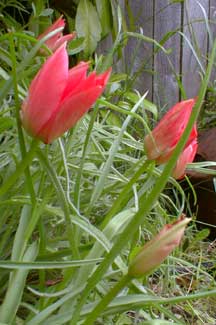
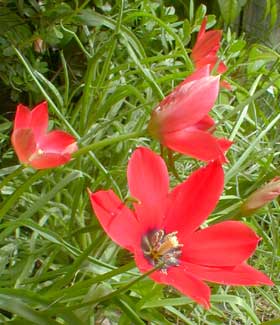
"Though they expel me from two hundred cities,
I bear it for the sake of the love of a prince;
Though my shop & house be laid waste,
I bear it in fidelity to a tulip bed."
-Mewlana Jalaluddin Rumi
(1207-1273)
We planted Tulipa batalinii 'Red Gem' not many feet from some well-naturalized 'Bright Gem' of the same species, with the expectation that the added bulbs would have similar behaviors.
But 'Bright Gem' bloomed in April, 'Red Gem' in May. 'Bright Gem' when closed on overcast days looked like an origami pyramid; 'Red Gem' had no pyramidal shape when closed. 'Bright Gem' had fairly sturdy stems but 'Red Gem' was a mite floppy.
The primarily yellow 'Bright Gem' has been such a splendid botanical tulip that the impressiveness of 'Red Gem' suffered by comparison, though getting away from the comparisons, 'Red Gem' is also a lovely tulip. It's especially nice that it appears comparatively late in the season when the rest of the botanical tulips are finished.
On overcast days, or in the afternoon when its location is shaded, 'Red Gem' is a closed flower & shows its red outer petals quite handsomely. When full sun directly hits them, they open into veritable stars, with the inner petals fabulously intensely vermillion.
'Red Gem' stands five or six inches tall, leaning into the sun. It will naturalize & colonize with ease any site that is hot & sunny. It's best to remove the flowers as soon as they are spent, but before they go to seed, so that the bulbs expend more energy creating offsets rather than seeds. But leave the grassy foliage to die back on its own, or snip it when it yellows.
The species is native to Iran, Uzbekistan & Turkestan. It is named for the Russian botanist Alexander Feodorowicz Batalin (1847-1896), curator from 1870 until his death of the Imperical Botanical Garden at St. Petersburg.
-
a n i r t a k

 Re: Tulips
Re: Tulips
'Burgundy'
Lily-flowering Tulip
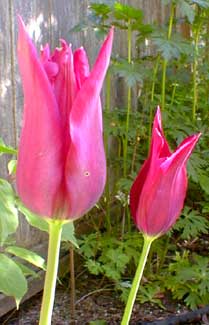
"Like tulip-beds of different shape & dyes,
Bending beneath the invisible west-wind's sighs."
-Thomas Moore's
Lalla Rookh:
The Veiled Prophet of Khorassan
While planting autumn bulbs in 2003, we placed four 'Burgundy' with four 'China Pink' Lily-flowering tulips by a gatepost near a female kiwi. In a shallower layer above these tulips we laid in over two-dozen 'Whitewall Purple' snow crocuses. The location is quite sunny, getting a good deal of late-morning & early-afternoon sunlight.
The dark almost electric purplish-violet 'Burgundy' was introduced in 1957, a spontaneous mutation of the rose-purple 'Captain Fryatt.' The blooms, occuring April & especially in May, are approximately two feet tall, vase-shaped with pointed petals. It perennializes easily & over time can spread in place.
Although Lily-flowering tulips have had their own division for only a few decades & were formerly included amidst the Cottage Tulips division, we know from Ottomon tile paintings that Lily-flowering tulips have been in cultivation a great long while, & were an artistic ideal preferred over egg-shaped tulips. The "flame-like" petals best captured the symbolic meaning Divine Fire, the fiery essence that gives life to the world & which causes the mystic to seek Allah with an ecstatic desire like unto a husband for a wife, so that God is even said to be "Peri-faced," that is, as a beloved fairy-wife to humanity.
The species heritage of the lily-flowering group is lost to time, but it is certainly older than its relatively modern group-categorization implies. The majority of Lily-flowering tulips would have T. fulgens & T. retroflexa in their earlier heritage, with modern hybriders adding T. acuminata to extend the varieties.
There are not nearly so many varieties as there are for the major egg-shaped hybrids. Many of the earliest varieties have died out of the trade due to weak stems & other problems. The modern lily-flowering tulips have been developed with stronger stems.
-
a n i r t a k

 Re: Tulips
Re: Tulips
'Carnaval de Nice'
Peony Tulip
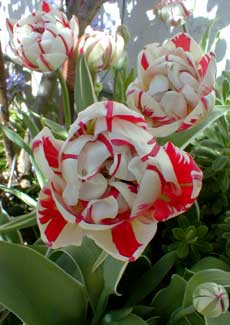
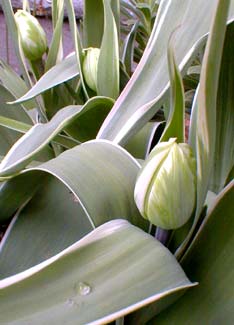
"The tulip is a courtly quean,
Whom, therefore, I will shun."
-Flowers
by Thomas Hood
(1799-1845)
The correct spelling of this tulip cultivar is 'Carnaval de Nice,' but about half the time it is corrected to the English spelling "Carnival" in catalog listings. It is named in honor of the world-famed flower-floats at the Carnival of Nice.
In late March, the fat buds are green & ivory, in the exact shade of the leaves which are variegated green with ivory edging The second photo (below right) shows them toward the end of March when they are beautifully striped buds.
At this stage they look exactly like certain Viridiflora tulips, such as 'China Town.' These buds will further fatten day by day, remaining green & white streaked.
But then as the buds mature they show red in the cracks, & at long last they burst open. As full flowers, the green streaking is no longer a feature.
What unfolds is a Double Peony Tulip, a large globe of many petals which are white with wide ragged raspberry-red streaks or "flames."
They really do look rather like old classic peony flowers when fully opened at its height of bloom.
These extravagant blooms begin about the end of the first week in April & last into May. They rise on slender stems to around twenty inches of height, or shorter.
'Carnaval de Nice' was introduced to European gardening in 1953, supplanting similar cultivars a century older which were faulted for weak stems. Though today strengthened, peony tulips are still at risk of being beaten down by harsh weather.
Ours are protected by small trees & a large rose bush that surround our little "tulip field," near enough the house that a bit of an overhanging eave keeps them from becoming too easily beaten down by the rain.
-
a n i r t a k

 Re: Tulips
Re: Tulips
'China Pink'
Lily-flowering Tulip
"A tulip garden is
endless imagery
of the holy splendor
of the majestic Spirit."
-Jalaludin Rumi
(1207-1273)
The word Tulipan was an intentional wordplay on Tuliben (Turban) because of a presumed resemblance between the round goblet flowers & a gentleman's turban. This was more apt to be the impression of tulip appearance to westerners than to Islamic peoples, who viewed the tulip not as a headdress, but as a type of Divine Fire.
The Persian word for Tulip is Lalah. Among Sufis the tulip symbolized the Peri-face of God, a Peri being a delightful fairy or female djinn. The very Moon was said to possess this Peri-face. Allah as Peri-faced means that the One is akin to a loving bride to humanity. Lalah is thus a name of the Soul which is of God & which is that part of ourselves which desires God as the Beloved.
At the martyrdom of the Prophet's son Husayn, where his blood flowed in the desert there arose tulips. It is believed that the reason tulips are so frequently seen in shades of scarlets, pinks, & burgundies, is because they were at one time mired in blood. Their continued redness is the brand of their grief. Husayn's blood persists as a field of tulips which are grown in his blessed memory & honor in the desert around Mecca.
Because the Tulip represents a kind of ecstatic love between humanity & the divine realm, such as is at the same time the fiery essence of Life, the ideal Tulip in Turkish art had pointed reflexed petals, looking like flames. Today we call these the Lily-flowering tulips, the most sacred of a sacred genus.
Early October 2003, we planted four 'China Pink' bulbs together with other bulbs by a gatepost near a female kiwi, with a layer of many 'Whitewell Purple' crocuses planted in a shallower level above those. The crocuses come & go well before it is time for the tulips to bloom.
As 'China Pink' is a recipient of the Award of Garden Merit, it was assured to be beautiful, easy to grow, & of lasting garden value. It was introduced in 1944 by De Mol & A. H. Nieuwenhuis of Holland. The Nieuwenhuis brothers were notable pioneers in developing the relatively recent division of tulips called Lily-flowering.
'China Pink' is a small-flowered lily-tulip, pink with white base, & a lighter pink rim, reaching only about fourteen inches of height. These are generally said to bloom, like the majority of lily-tulips, in May, but in our garden they are flowering by the first week in April.
Lily-flowering tulips are a small division that were previously included amidst Cottage Tulips. They are still sometimes lumped together as "Mayflowering Tulips" including also Darwins. The primary parents of the whole division are Tulipa acuminata, T. fulgens & T. retroflexa.
Lily-tulips tend to have slim stems that look delicate, but most are pretty good at standing sturdy & upright, with the flowers always having pointed petals increasing the impression of an upward thrust.
As a generality Lily-flowering tulips perennialize in place, returning stronger than ever for many years. In spring before the first tulips are rising up, they should all recieve generous amounts of bone meal, fish meal, blood meal, or kelp, but do not require nitrogen fertilizers. A winter top-coating of steer manure or leafmold can be beneficial.
-
a n i r t a k

 Re: Tulips
Re: Tulips
'Cynthia' Lady Tulip
aka Candlestick Tulip
"In the intimate dark there's never an ear
Though the tulips stand on tiptoe to hear."
-Hora Stellatrix
by Amy Lowell
Formerly thought to have been native of the Middle East, Tulipa clusiana was sometimes known as the "Persian Tulip" for the belief that it originated in Persia. Even today, some texts continue to insist its native range is from Iran, Afghanistan, Uzbekistan, Tibet & Kashmir in northern India.
If they'd added in Turkey they'd've hit all the bases with the odds of it having been partially correct seemingly a gambler's sure thing. However, the best experts now believe it to be indigenous to Spain! Uncertainty remains since it has managed to naturalize in so many regions, having been gardened through much of Europe since the early sixteen-hundreds.
That it escaped to so many wild locations is somewhat mysterious since it does not seed & would be expected mainly to naturalize from offsets & by its wandering underground stolons, which ought to leave them fairly close to where initially planted planted.
It must once have been so widespread in rural gardens that in some places there is no longer evidence of homesteading, except for the forever lingering hardy Lady Tulips.
Its mysteriousness of origin hints at the greater difficulty botanists have had retrospectively attempting to assess the origination of so many varieties of tulips. If the origin of a species tulip can be so uncertain, how much greater the difficulty in tracking down centuries of hybridizations. To date, the amazing diversity of the thousands of hybridized tulips cannot be tracked to any conceivable combination of wild species.
Today the sundry selected varieties of T. clusiana are collectively known as Candlesticks or Lady Tulips. The first April photo above shows 'Cynthia' just before the flowers open, when their "candlestick" appearance is at its most extreme. The second photo, a day or two later, shows the opening bloom.
The species is named after Clusius whose Curae posteriores (1606) mentions obtaining bulbs from a Florentine grower who had received them in 1606 from Constantinope. Clusius's bulbs were flourishing a year later. It was already at that time dubbed the Lady Tulip.
The species is usually red & white resembling a peppermint stick, but the variety 'Cynthia' is striped red & yellow. 'Cynthia' was introduced to gardeners in 1959 by C. G. Van Tubergen. In our roadside sun-garden, the tall slender buds are coloring up & attractive after the first week of April. The pointed "flames" of the candles open into flat perfect stars by mid-April, lasting into May.
They grow eight inches to a foot tall. They require a warm & sunny location. Despite not seeding, this tulip easily increases by bulb offsets. It perennializes without effort, though it is somewhat at risk of winter rot if it experiences too much moisture during dormancy. With perfect drainage, in organically enriched sandy soil, they should come back yearly & spread on their own.
Occasionally T. clusiana expends so darned much energy creating roots, offsets, & stolons that it forgets to bloom quite well enough, & may need to be lifted to replant rather more often than other botanical tulips. So long as it has a warm, sunny location, however, it will eventually be productive & rewarding.
They sometimes seem to beg for propogation help, which means digging them up after they are done flowering & after the leaves have begun to die back, this in order to remove offsets & start them in pots until they are mature enough to go back into the garden. (The main bulb can be immediately placed back in its hole as soon as the offsets are harvested.)
To maximize the possibility of it naturalizing in place, however, do not trim foliage after it stops flowering; always wait for it to die back on its own. If the leaves are pruned back the bulbs will weaken & offsets will not mature. Position Lady Tulips where they will get maximum sun or full afternoon sun, & don't water them much. Though they love summer heat they are nevertheless temperate tulips for USDA zones 3 through 8; in zones with warmer winters they will not complete their life cycle because they require a chilly dormancy.
Growing immediately right of 'Cynthia' is a wild form of the same species, T. clusiana var chrystanthus.
-
a n i r t a k

 Re: Tulips
Re: Tulips
'Chrysantha' Lady Tulip
or Candlestick Tulip
"Like a tulip's flame I burn
In your presence as I turn;
By my life, & yours, I swear
Youth of Persia ever fair!"
-Allama Iqbal
(1877-1938)
Tulipa clusiana var chrysantha is sometimes listed as its own speces, Tulipa chrysantha, & sometimes sold as though the cultivar name were 'Chrysantha.'
It is very similar to T. clusiana 'Cynthia,' but where 'Cynthia' is ivory white & pink-red, 'Chrysantha' is yellow & orange-red.
'Chrysantha' is in full bloom a week or so sooner, & 'Cynthia' is still around when 'Chrysantha' is fading, so they make lovely companions to maximize the period of time when the lady tulips are present.
These two strains are planted in such close proximity so that the two small drifts of lady tulips blend into a single drift with more impact. They do not hybridize because T. clusiana varieties cannot produce viable seed, but each grouping reproduces offsets to increase their numbers.
If after three or four years they seem to have grown "tired" & don't bloom, they should be lifted after the leaves begin to die back, the offsets removed, & replanted.
When fully open on strongly sunny days, the blooms form bright yellow stars (hence formerly called Tulipa stellata). The second April photo shows them on just such a sunny day, with the red outsides hidden beneath the flowers' outspread petals.
It doesn't take much of an overcast to keep them from opening all the way, but when they're partially closed they show more of the bicolor exterior petals, as in the first photo above & fourth photo below.
This species variant is native of harsh regions of Uzbekistan, hence very hardy & easy to grow in the garden. It needs moist well drained soil while in spring growth, & hot well-sunned soil during summer dormancy. It grows eight to twelve inches tall. It can tolerate a bit of shade, but like most tulips will really do best in full sun.
The bulbs like to be planted a full six inches deep, so it is possible to layer over them another bulb at a much shallower level. We planted only five 'Chrysantha' bulbs; & over them, at three inches depth, went a grape hyacinth look-alike Bellevalia pycnantha.
The Bellevalia is budding a mat-finish blue by mid-March, but the buds develop quite slowly. So by the time it is getting big & swollen & really looking like a grape hyacinth, that's exactly when the candlestick buds of 'Chrysantha' are opening up, at the very tail-end of March or in early April. It was blind good luck, but these flowers look tremendous together, with long-overlapping bloom times.
-
a n i r t a k

 Re: Tulips
Re: Tulips
'Portofino' Tulip
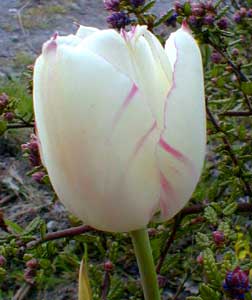
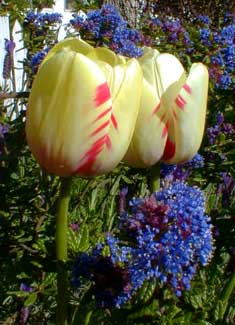
When tulips bloom in Union Square,
And timid breaths of vernal air
Go wandering down the dusty town,
Like children lost in Vanity Fair;
When every long, unlovely row
Of westward houses stands aglow,
And leads the eyes to sunset skies
Beyond the hills where green trees grow;
Then weary seems the street parade,
And weary books, & weary trade:
I'm only wishing to go a-fishing;
For this the month of May was made.
-When Tulips Bloom
by Henry van Dyke
(1852‚1933)
'Portofino,' meaning "Boggy Port," is named for an Italian seaside resort town near Genoa. It & one other tulip ('Princess Irene') were given to Granny Artemis & I by a local nurseryman, as spent potted flowers.
Since we didn't select these, & since they were to be planted in the wrong season out of pots instead of properly as autumn bulbs, they were placed together in an unimportant sunny location out by the road, then left to fend for themselves. They fended well enough, & two 'Portofinos' arose the following spring.
'Portofino' stems are about two feet high. For us it flowers before mid-April, though often defined as May-flowering. Ideally the blooms are large singles with overt ragged red flames, but these freebies produce blooms that are smallish.
They begin creamy-yellow but soon fade to ivory-white, with little dabs of red flames that become a bit more overt as the flower ages.
As it is fading from palest yellow to a more nearly pure white, it goes through a cloudy stage as the yellow fades unevenly; the second photo captures this middle-stage. The blue-flowering shrub framing the tulips is a west coast native, Santa Barbara Mountain Lilac.
Many fancy hybrid tulips weaken with each year, until they no longer flourish, but the Darwin hybrids tend to perennialize very nicely. They produce one big bloom per tall stem, usually sturdy enough to not be knocked over by normal degrees of wind & rainfall.
-
a n i r t a k

 Re: Tulips
Re: Tulips
'Apeldoorn Elite'
Darwin Hybrid
I asked the Tulip, "You are so beautiful but your heart is black. Why is this so? Has some friend done you an injury?"
The Tulip replied, "I have no gold such as is the source of happiness."
Ibn-i-Yamin,
d. 1345
Granny Artemis was handed a tulip bulb in a small sandwich baggy at a peace event in Seattle in 2002. The baggy was packed with compost made from flowers that had been part of the Seattle Center Flower Vigil after the September 11 attacks in 2001. In the bag of compost was one Appledoorn Tulip grown in the Skagit Valley. Mayor Greg Nickels had a printed note attached to the bag that said "Plant this bulb in memory of those we lost & as a living symbol of our values of freedom & unity."
As the tulip is red with faint orange streaking, I suppose this is a cooptation of "Red Poppy Symbolism," but in this case used not in sincere memorial, but primarily as an advertisement for a tulip grower. The flyer that came with this freeby had lots of room left over for a quick sentence on how deep to plant the bulb in what kind of soil, but that'd spoil the purpose; instead, to find planting instructions, it tells you to go the sponsor's commercial website & get bombarded with commerm.
It reminded me how Ford Trucks rushed their advertising to the television airwaves soon after the towers fell, insinuating it was patriotic to go out right then & there & buy a big gashog of a truck. The ad got pulled fast, but how is it even possible they failed to predict the instantaneous backlash, which was just so inevitable.
Everyone for commerce & for political gain was at that time tying their product or their campaign to the Flag, Apple Pie, & Falling Towers, which works ever so much better than the risky business of stepping forth in support a civil rights, or peace in our time, or anything with more substance than jingoism going for it.
"Contribute to my campaign & stop terror!" "Buy my tulips & stop terror!" While at the same time, any ordinary tramp who asks "Buddy can you spare a dime" is at risk of being arrested, & the federal government sent out instructions to local police to consider anyone who owns an Almanac a potential terrorist.
So instead of "Buy this magazine or we shoot the dog" it's "Buy this (political claptrap) (Ford) (tulip) or the Terrorists win."
Screwy damned world that cannot separate out its grief from its profit margins, which welcomes a boogyman for the sales angle it provides, while expressing zero interest in actual civil rights of all people. But hey, it's a capitalist society after all, & no catastrophe passes without someone making a commercial out of it.
I don't actually want my gardens to become a place to contemplate terrorism, so I couldn't applaud having violence & doom imposed on a flower, nor can I find praise for the politicalization of simple hucksterism posing as memorial. If I did want a flower to remind me of terrorism, it wouldn't be a particolored red & orange striped baffoon of a carnival tulip. I actually liked the idea of the composted vigil flowers more than the bulb itself.
But what the hell, free is free, & I planted it anyway, though not anywhere where it would spoil an overall woodland effect with its gaudiness. Just out on the road in front of an exiled Ceanothis.
I would never have bought this tulip. Darwin hybrids are among the biggest tulips (for flower size), but I'm enamored of little botanicals. Still, I couldn't just throw it away, that'd be unamerican & ex-liberal neo-conservative clownster Dennis Miller wouldn't like me anymore.
For its first year, the lonely bulb sent up a little patch of thick green leaves in late Autumn rather than waiting for Spring. Then it lurked there all winter long waiting for spring, & in April bloomed quite nicely.
The first two photos show it in 2003, a single tall flower bright red with silvery sheen, & black in the center. Many hybrid tulips weaken year by year, but Darwins can perennialize with ease. The third photo shows it again in April 2004 (with plenty more deaths to commemorate in the meantime), three flowered stalks arose where the previous year was only one.
-
a n i r t a k

 Re: Tulips
Re: Tulips
'Menton' Darwin
Single Late Perennial Tulip
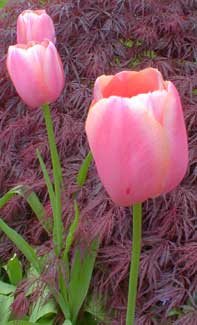
"You can't see fairies unless you're good.
That's what Nurse said to me.
They live in the smoke of the chimney,
Or down in the roots of tree;
They brush their wings on a tulip,
Or hide behind a pea."
-Marchette Gaylord Chute
(1909-1994)
'Menton' Darwin tulip is largely salmon-pink but with pastel apricot highlights & sometimes appears to be lightly glazed with peach & rose. In all it is the color of a particularly striking dawn.
It is named for Menton on the French Riviera against the foothills of the Maritime Alps, an amazing backdrop for gardens both famed & incidental. The slogan of Menton is appropriately "My village is a garden."
'Menton' stands twenty-six to thirty inches tall with a large pyramidal to eggshaped flower that when opened in fullest sun can be as much as six inches wide.
The many & various Darwin tulips were achieved by crossing T. darwin with T. fosteriana. Such tulips are also known as Mayflowering, Cottage, or Perennial tulips. "Single lates" are a catch-all of tall tulips that bloom mainly in May, but those which can be additionally categorized as Darwins are the best of the single-lates for several reasons:
They are the tallest & largest tulips ideal for cut flowers, are long-lasting in the garden, with sturdy stems not e to lodging, & unlike so many other hybrids they will perennialize for many years, so long as the leaves are not cut back until they're very faded.
'Menton' burst into bloom late April & mostly in May. It looks good popping up singly amidst shorter leafy perennials, or in drifts of many. It originated as a sport of the pure rose-pink 'Renown.' The sport was developed by W. Dekker & Sons for release in 1971.
-
a n i r t a k

 Re: Tulips
Re: Tulips
'Queen of Night' Tulip
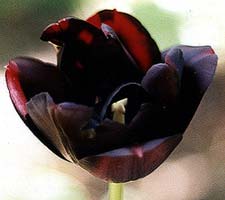
"Men plant tulips upon dunghills
when they wish them finest."
-Elizabeth Barrett Browning
We have planted almost exclusively botanical tulips, but a few large hybrids pop up here & there even years after they were planted. Hybrids don't naturalize as well as botanicals, so the hybrids are of uneven quality over time. Even so, the few Triumph Tulips that persist we make no attempt to dig out or discard, as they're interesting even if minor; & when we were given a freebie Apeldoorn Darwin tulip we figured what the heck, & planted it.
When these old bulbs have been in the way of something important, I have occasionally dug them out, whether to discard or replant out of the way. It is sometimes shocking how deep in the ground they are buried! Certainly no gardeners ever planted them so deeply. Some tulips have retracting roots that literally pull the bulb a little further down each year.
Among the "ordinary" hybrid tulips that pop up here & there in the garden, one that is quite likeable is 'Queen of Night' which would make a fine choice for a "Gothic Garden." Its nearly black flower is shown in an April 2002 photo above. It is a deep chocolate-purple that purports to be one of the blackest of tulips, & some of them in the right light do look very black. The variety has probably been in peoples' gardens since the 1920s, but was only given its name in 1944.
The elusive quest for a true black tulip remained for decades no better found than in 'Queen of Night.' Indeed growers have been striving to develop a true black tulip for centuries without quite achieving it.
The unachieved Black Tulip became a symbol, akin to that of the Blue Rose, of high Romantism. If the poet's dream of the Blue Rose was the Romanticist ideal of unachievable perfect beauty, the Black Tulip was the symbol of deep dark cruelties, as it indeed symbolized for Alexander Dumas in his novelette The Black Tulip (1850), a sensationalist tale of greed, torture, murder, & the unwholesome desire of tulip growers to obtain the titular flower.
For decades 'Queen of Night' stood as the closest that existed to the ideal. Some have said the 1984 sport of 'Queen of Night,' dubbed 'Black Hero,' is a step closer, but really it is a step closer to brown & 'Queen of Night' is a better color. 'Black Hero' however has more petals. The coolest of the fake blacks is 'Black Parrot,' developed in 1934. It's a very frilly tulip which, while hardly black at all, is such a macabre bloody red-black as to seriously fulfil the gothic intent.
If I were selecting an allegedly "black" tulip right now, it would probably be 'Black Parrot' instead of 'Queen of Night.' But we're not terribly likely to have any of the other "black" tulips because we've largely turned out backs on hybrids, & have become much more seriously enamored of little species tulips.
-
a n i r t a k

 Re: Tulips
Re: Tulips
Golden Emperor Tulip
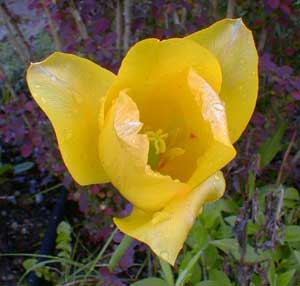
I saw the Divine Shekhinah treading through the night
murmuring, "sela, sela, sela"
meaning, "stone, stone, stone."
I saw Lilith skipping through a sunlit field in Persia
singing "lala, lala, lala,"
meaning "tulip, tulip, tulip."
-j.a.s.,
2004
This Tulipa fosteriana or Emperor Tulip is 'Golden Emperor' aka 'Golden Purissima' aka 'Yellow Emperor,' occasionally sold as Golden or Yellow Empress.
Fosteriana tulips are longlived in the garden, returning for many years. They are early bloomers, of medium height, on average fourteen inches.
The original species tulip from which the whole group was derived was a bright red native of mountainous regions of Turkestan. The first wild red specimens that made it to Holland were collected by Joseph Haberhauer; it would not become widely available in cultivated forms until three decades later. Today's bright red clones which most resemble the wild Fosteriana are sold under the name 'Red Emperor' though it is actually registered as 'Madame Lefeber' after the wife of the Holland grower Dirk Lefeber, who experimented with the species early in the 20th Century & established the first cultivated forms of what became the Fosteriana Group.
'Golden Emperor' blooms in April, lasting long into May. The sturdy stems are not bothered by wind or rain & stand very upright. The bulbs are placed in autumn six or eight inches deep (measured to the bottom of the bulb), at least four or five inches apart. They open fully only when planted in full sun. They do well in zones 3 through 8, & can withstand rather droughty conditions even during their blooming period, though blooms may be larger with occasional watering.

History's (& myth's) Yellow Emperor was the ancient Taoist philosopher, Huang-ti or Huang Di, founder & first emperor of the Chinese nation, in the 23rd Century B.C.E. "Huang" means Yellow, & "Huangdi" means Emperor, so his name is an affectionate pun. He was the author of the world's oldest surviving medical text, Huang-ti Nei Ching ("The Yellow Emperor's Classic of Medicine").
He is said to have invented the wheeled cart, the slipper boat, bricks & masonry, the magnetic compass, plus his interest in astronomy led to his devising the first Chinese calendar. His wife, Empress Lei Zu, was equally clever. One day sitting under a mulberry tree, a silkworm cocoon fell into her hot tea, from which event she was able to deduce all the methods by which silkworms are raised & their cocoons boiled to be woven into silk cloth. She is regarded as the Taoist Goddess of Silk.
-
a n i r t a k

 Re: Tulips
Re: Tulips
'Georgette'
Multi-flowering Tulip
"See here! -- a Tulip richly laced
to please a royal fairy's taste!"
-George Darley
(1795‚1846)
'Georgette' is one of the most vigorous of multiflowering, multi-headed, or bouquet tulips.
The category of multiflowering tulips is only semi-official, & they are not really of a single type, some short ones being bred from greigii tulips, the tall ones from triumphs, early, or late flowering hybrid tulips.
Even though their heritages & appearances diverge dramatically in size & bloom period, they nevertheless have this one behavior that is so unique that gardeners cannot help but lump them together as "multiflowering."
A single stem rises from each bulb then divides into anywhere from two to seven flower heads. One of ours had nine blooms. The first photo shows a single bulb's production of five, three at the top of the stem, & two more from forks halfway down the stem.
'Georgette' happens to be a single-late tulip, eighteen to twenty inches tall. The catalog said it blooms in May, but in our garden it was in full bloom by mid-April, when the photos on this page were taken.
The single-late class is itself a catch-all of tulips so long crossbred & re-crossbred that it is no longer possible to identify them as Darwins, or Cottage hybrids, or any other particular class with which they might once have been associated. The commonality of single-late tulips is that they tend to be among the last of the tulips of the year to reach full flower, & each bloom is the basic minimal egg type. The group tends also to be fairly tall, though 'Georgette' is only moderately so.
Their half-opening egg-shaped blooms express themselves in clear yellow or orange-sherbert; the first two photos show the perfect yellow clearness.
As the blooms age they gain slender outlining streaks of brightest scarlet, as can be seen in the third photo just getting started. Before the flowers are fading, the red edging will have bled further & further into the petals.
It will do well in chilly or temperate climates, but 'Georgette' will not do well above Zone 8.
Our gardens have more botanicals than hybrid tulips, & the hybrids are not our personal favorites because they cannot naturalize, & many aren't even as longlived as single bulbs. The multiflowering 'Georgette' is apt to produce its amazing hydra-headed flower bunches for only two years running before the bulbs begin to wear themselves out. Such a feature can actually be used to advantage if there are areas which need temporary color but which spots will be needed for other things after a year or two.
We placed ten 'Georgette' bulbs in a high-sun-exposure area. That same night a racoon dug up the bulbs but left them unbitten. I had used some bonemeal with the planting & this is what attracted the racoon, so in replanting them I added some very plain soil over the surface hoping it wouldn't smell so interesting to the racoon a second time.
This patch of multiflowering tulips was situated alongside two dwarf pomegrante bushes, but "dwarf" means they won't become trees, not that they're otherwise tiny. These pomegrantes can actually become substantial shrubs, so that after a couple of years there will no longer be room for the tulips, so it's no problem that the bulbs will most likely be worn out by then.
-
a n i r t a k

 Re: Tulips
Re: Tulips
Greig's Tulip 'Chopin'
"Like a tulip, my robe I'll rend,
and come forth, O Padmani,
as thy beloved."
-Ghulam Rasool Mir,
Kashmir,
India
Tulipa greigii 'Chopin' bears a cultivar name after Frederic Francois Chopin (1810-1849).
Chopin honored just such garden flowers in his "Raindrop Prelude," & Chopin's personal & amazing gardens outside Warsaw remain world famous to this day. So few have ever been so deserving of having a flower named in their honor.
In color this variety is creamy-white to lemon-yellow, with streaking tints of crimson, plus there are red streaks on the blue-green leaves which are themselves decorative well before its late March & April blooms.
We started with only three 'Chopin' tulips plus four 'Oratorio' mixed in a larger drift of 'Red Riding Hood,' all of which are greigii tulips. 'Orotorio' blooms two weeks ahead of 'Red Riding Hood,' & 'Chopin' three weeks ahead, being in full flower by the last week of March, the others mainly in April.
The three bulbs we started with already had offsets. In autumn we lifted all the greigii bulbs to move to a sunnier location, & were suprised that between one autumn & the next the bulbs had greatly multiplied.
The first two flower photos are from March 2003 in the previous location, & the third photo shows considerble increase in the new location late in March 2004.
The species is one of the largest-flowered & with more cultivated varieties than any of the botanicals. It is native of Turkestan, Kazakhstan, Kyrgyzstan & Uzbekistan, with color variants over its range that have helped to develop many brightly colored garden forms.
Furthermore, it can be hybridized with kaufmanniana "water-lily type" tulips, further broadening the range of varieties. At some point it seems to me that they should cease to be regarded as botanical tulips but only additional hybrid varieties, but they are all still cataloged as botanicals.
In almost any array of species tulips, the greigii cultivars will stand out. It is a miniature as to height, the eight inch brownish leaves bending so that they grow nearly horizontal to the ground, & in themselves quite showy.
Most greigii tulips have red-striped leaves; 'Chopin' has the stripes fainter than most, & the stripes fade away by the time the whole drift is in full flower. Above the leaves, large blooms on short stems rise no more than a foot. The flowers are big-horned cups that on sunniest days open into stars with as much as a five-inch spread.
They open widest in fullest sun, but bloom just as nicely in light shade, where the flowers may retain a somewhat closed upright appearance as in the topmost late March portrait. The second photo also from late March shows the fully open appearance that occurs on a good sunny day, showing the zones of color in the throat.
Even on rainy or overcast days when they might not open all the way, they're perfectly gorgeous. They also stand up to a hard rain better than some of our other species tulips, as a few of the others get beaten down by rainy weather.

The species was first described in 1877 by Eduard August von Regel (1815-1892), director of the St Petersburg Botanical Garden. He named it for Sir Samuel A. Greig (1735-1788), shown in the engraving at the right.
Sir Samuel was born in county Fife in Scotland. He served in the British Navy & fought in battles against France & in the New World against Cuba, but he made his real mark on naval military history during the reign of Catherine the Great.
In 1764 he joined the Russian Navy & fought battles against the Turks & the Swedes, becoming a Knight Admiral still remembered as "the Father of the Russian Navy." The mezzotint portrait of Sir Samuel Admiral Greig here at the right is by Dmitri Levitsky, first published in 1778.
'Chopin' like other cultivars of Greig's Tulip naturalizes easily. It is a good choice for containers or indoor forcing, ideal for rockeries or fronts of borders.
It takes hardly any care, & responds very well toour region's wet springs & dry summers.
 Posting Permissions
Posting Permissions
- You may not post new threads
- You may not post replies
- You may not post attachments
- You may not edit your posts
Forum Rules










